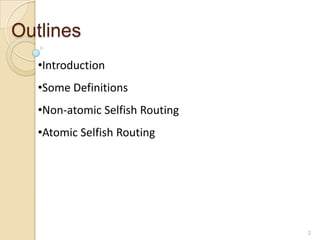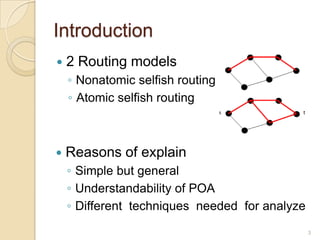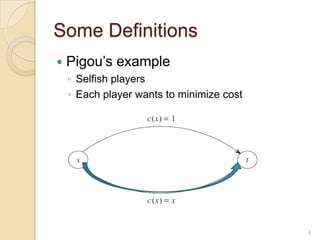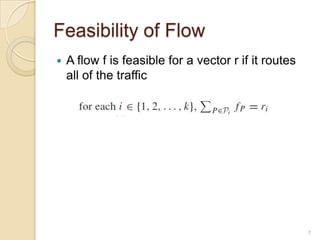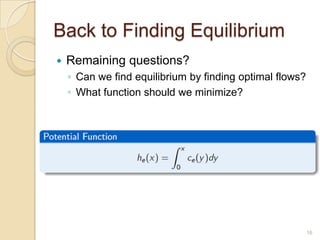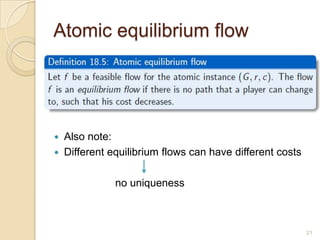Routing games
- 1. Routing Games By Javad Ghareh Chamani 1
- 2. Outlines âĒIntroduction âĒSome Definitions âĒNon-atomic Selfish Routing âĒAtomic Selfish Routing 2
- 3. Introduction ï 2 Routing models âĶ Nonatomic selfish routing âĶ Atomic selfish routing ï Reasons of explain âĶ Simple but general âĶ Understandability of POA âĶ Different techniques needed for analyze 3
- 4. Some Definitions ï Pigouâs example âĶ Selfish players âĶ Each player wants to minimize cost 4
- 5. Multicommodity Flow Network ï Directed graph G = (V, E), may have parallel edges ï Commodities: set of source/sink pairs: (s1, t1),âĶ,(sk , tk ) ï Assign each player to asome commodity ï nonnegative, continuous, non-decreasing cost function ce 5
- 6. Multicommodity Flow Network (cnt) ï Paths ï Routes âĶ Traffic described with flow f âĶ fP: amount of traffic of commodity i that chooses path to travel from si to ti âĶ Prescribed amount of traffic for commodity i : ri 6
- 7. Feasibility of Flow ï A flow f is feasible for a vector r if it routes all of the traffic 7
- 8. Cost Definition ï Cost of a path P with respect to a flow f ï fe amount of traffic using paths that contain the edge e. 8
- 9. Nonatomic Equilibrium ï A flow (f) is equilibrium if: no commodity can increase its gain by changing its traffic 9
- 10. Braessâs Paradox ï One commodity ï wants to route 1 unit of traffic ï from s to t 10
- 11. Braessâs Paradox(cont) ï New equilibrium ï Old cost: 1.5 ï New cost: 2 11
- 12. Existence & Uniqueness of Equilibrium ï There exists at least one equilibrium ï All equilibriums are equivalent (of equal cost) ï Using Potential Function 12
- 13. Potential Functions ï Let ce(x) be the cost of transporting x over some edge e ï The total amount spent on that edge is x.ce(x) 13
- 14. Marginal Cost and Optimality Follows from convex optimization problem nonnegativity constraints 14
- 15. Marginal Cost and Optimality(cnt) ï How to minimize the total marginal cost? Create a new network with the marginal cost as cost function, and find an equilibrium. 15
- 16. Back to Finding Equilibrium ï Remaining questions? âĶ Can we find equilibrium by finding optimal flows? âĶ What function should we minimize? 16
- 17. Potential Function ï We want to minimize the functions he(x) of all edges. The sum of those is called the potential function and should be minimized. 17
- 18. Consequences ï The potential function is convex: âĶ there exists a minimum, and therefore an equilibrium âĶ and all equilibriums form a set âĶ with the same cost 18
- 19. Atomic Selfish Routing ï Almost the same as the nonatomic instance. ï Differences: âĶ Each commodity represents ONE player instead of a large number of players. âĶ Player i must route traffic amount ri on a SINGLE path. ï Result: Each player must route a significant amount of traffic instead of a negligible amount. 19
- 20. Feasibility of a flow ï A flow f is feasible if: âĶ it routes all traffic âĶ it uses one path per player i to route ri units 20
- 21. Atomic equilibrium flow ï Also note: ï Different equilibrium flows can have different costs no uniqueness 21
- 22. Nonexistence of equilibria ï Traffic amount: r1 = 1; r2 = 2 ï P1 s -> t ï P2 s -> v -> t ï P3 s -> w -> t ï P4 s -> v -> w -> t ï 1- If player 2 takes P1 or P2, player 1 takes P4. ï 2- If player 1 takes P4, player 2 takes P3. ï 3- If player 2 takes P3 or P4, player 1 takes P1. ï 4- If player 1 takes P1, player 2 takes P2. ï This does never end. . . 22
- 23. Difference of Atomic and Non ï Different EQ of an atomic instance can have different costs ï Nonatomic EQ have same cost ï POA in atomic instance can be larger than nonatomic 23
- 24. Overcome nonexistence of equilibrium To guarantee an equilibrium, additional restrictions are placed on atomic instances. For instance: Give all players an equal amount of traffic which has to be routed. 24
- 25. Overcome nonexistence of equilibrium (cnt) 25
- 26. Proof ï In atomic instances we can discretize the potential function that was used for nonatomic instances: ï #Possible flows is finite. One flow f is a global minimum of 26
- 27. Proof (cnt) ï Claim: flow f is an equilibrium flow for instance (G,r,c). ï Suppose: Player i could strictly decrease cost in equilibrium flow f by deviating from path P to Pâ , yielding the new flow fâ : 27
Editor's Notes
- #4: Nonatomicvery large number of player each controlling negligible fraction of traffic.Atomic each player control non-negligible amount


